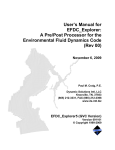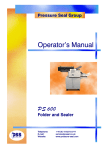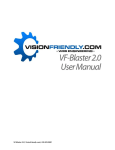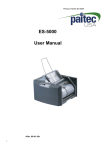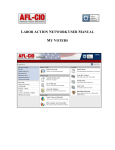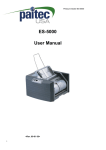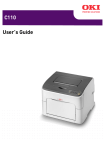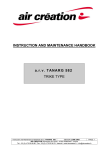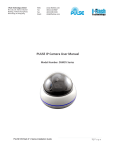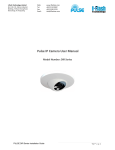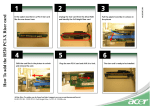Download Manual
Transcript
PS20/30 Operator’s Manual Issue 1 V-fold Z-fold C-fold Contents 1. Introduction General . . . . . . . . . . . . . . . . . . . . . . . . . . . . . . . . . . . . . . . . 1 Which side is which? . . . . . . . . . . . . . . . . . . . . . . . . . . . . . . . . . 2 How to use this manual . . . . . . . . . . . . . . . . . . . . . . . . . . . . . . . . 3 Safety precautions. . . . . . . . . . . . . . . . . . . . . . . . . . . . . . . . . . . 4 Operating environment. . . . . . . . . . . . . . . . . . . . . . . . . . . . . . . . . 4 Power requirements . . . . . . . . . . . . . . . . . . . . . . . . . . . . . . . . . . 5 If the PS20/30 is damaged. . . . . . . . . . . . . . . . . . . . . . . . . . . . . . . 6 2. Features General . . . . . . . . . . . . . . . . . . . . . . . . . . . . . . . . . . . . . . . . 7 Folder components Form guides . Feed roller . . In-feed tray. . Fold plates . . Fold rollers . . . . . . . . . . . . . . . . . . . . . . . . . . . . . . . . . . . . . . . . . . . . . . . . . . . . . . . . . . . . . . . . . . . . . . . . . . . . . . . . . . . . . . . . . . . . . . . . . . . . . . . . . . . . . . . . . . . . . . . . . . . . . . . . . . . . . . . . . . . . . . . . . . . . . . . . . . . . . . . . . . . . . . . . . . . . . . . . . . . . . . . . . . . . . . . . . . . . . . . . . . . . . . 8 8 8 8 8 8 Operator controls . . . Forms counter . . Green start button Red stop button . Jog function . . . . . . . . . . . . . . . . . . . . . . . . . . . . . . . . . . . . . . . . . . . . . . . . . . . . . . . . . . . . . . . . . . . . . . . . . . . . . . . . . . . . . . . . . . . . . . . . . . . . . . . . . . . . . . . . . . . . . . . . . . . . . . . . . . . . . . . . . . . . . . . . . . . . . . . . . . . . . . . . . . . 9 9 9 9 9 Power and safety components . Mains lead . . . . . . . . Power inlet . . . . . . . . Lid . . . . . . . . . . . . . . . . . . . . . . . . . . . . . . . . . . . . . . . . . . . . . . . . . . . . . . . . . . . . . . . . . . . . . . . . . . . . . . . . . . . . . . . . . . . . . . . . . . . . . . . . . . . . . . . . . . . . . . . . 10 10 10 10 Sealing components . . . . . . . . . . . . . . . . . . . . . . . . . . . . . . . . . 10 Pressure bolts . . . . . . . . . . . . . . . . . . . . . . . . . . . . . . . . . 10 Sealing rollers. . . . . . . . . . . . . . . . . . . . . . . . . . . . . . . . . . 10 PS20/30 Iss. 1. Page v 3. Set-up Setting up the PS20/30. . . . . . . . . . . . . . . . . . . . . . . . . . . . . . . . 11 Opening the lid . . . . . . . . . . . . . . . . . . . . . . . . . . . . . . . . . . . . 12 Removing the first fold plate . . . . . . . . . . . . . . . . . . . . . . . . . . . . . 13 Removing the second fold plate . . . . . . . . . . . . . . . . . . . . . . . . . . . 14 Replacing the fold plates . . . . . . . . . . . . . . . . . . . . . . . . . . . . . . . 15 Setting up the folder . . . . . . C fold set-up . . . . . . . Z fold set-up . . . . . . . V fold set-up . . . . . . . Adjusting the form guides . . . . . . . . . . . . . . . . . . . . . . . . . . . . . . . . . . . . . . . . . . . . . . . . . . . . . . . . . . . . . . . . . . . . . . . . . . . . . . . . . . . . . . . . . . . . . . . . . . . . . . . . . . . . . . . . . . . . . . . . . . . . . . . . . . . . . . . . 16 16 18 20 22 4. Operation General . . . . . . . . . . . . . . . . . . . . . . . . . . . . . . . . . . . . . . . 23 Operating process . . . . . . . . . . . . . . . . . . . . . . . . . . . . . . . . . . 23 Loading forms . . . . . . . . . . . . . . . . . . . . . . . . . . . . . . . . . . . . 24 Starting up and testing the PS20/30 . . . . . . . . . . . . . . . . . . . . . . . . . 25 Verifying folder settings . . . . . . . . . . . . . . . . . . . . . . . . . . . . . 26 Processing forms . . . . . . . . . . . . . . . . . . . . . . . . . . . . . . . . . . 27 Interrupting operation . . . . . . . . . . . . . . . . . . . . . . . . . . . . . . 27 5. Operation Errors Error Conditions . . . . . . . . . . . . . . . . . . . . . . . . . . . . . . . . . . . 29 Clearing mishandled forms . . . . Jam in folder . . . . . . . . Jam after folder . . . . . . . Pressure sealer bolt release . . . . . . . . . . . . . . . . . . . . . . . . . . . . . . . . . . . . . . . . . . . . . . . . . . . . . . . . . . . . . . . . . . . . . . . . . . . . . . . . . . . . . . . . . . . . . . . . . . . . . . . . . 29 29 31 31 Troubleshooting . . . . . . . . . . . . . . . . . . . . . . . . . . . . . . . . . . . 33 Page vi PS20/30 Iss. 1. 6. Cleaning the PS20/30 Cleaning procedure. . . . . . . . . . . . . . . . . . . . . . . . . . . . . . . . . . 37 7. Specifications Folder/Sealer Specifications Construction . . . . . Sealer. . . . . . . . . Size. . . . . . . . . . Weight . . . . . . . . Power . . . . . . . . Speed . . . . . . . . Environment . . . . . Feeder Capacity. . . . Noise . . . . . . . . . . . . . . . . . . . . . . . . . . . . . . . . . . . . . . . . . . . . . . . . . . . . . . . . . . . . . . . . . . . . . . . . . . . . . . . . . . . . . . . . . . . . . . . . . . . . . . . . . . . . . . . . . . . . . . . . . . . . . . . . . . . . . . . . . . . . . . . . . . . . . . . . . . . . . . . . . . . . . . . . . . . . . . . . . . . . . . . . . . . . . . . . . . . . . . . . . . . . . . . . . . . . . . . . . . . . . . . . . . . . . . . . . . . . . . . . . . . . . . . . . . . . . . . . . . . . . . . . . . . . . . . . . . . . . . . . . . . . . . . . . . . . . . . . . . . 39 39 39 39 39 39 39 40 40 40 Form Specification . . . Weights. . . . . . Sizes . . . . . . . Fold Configuration . . . . . . . . . . . . . . . . . . . . . . . . . . . . . . . . . . . . . . . . . . . . . . . . . . . . . . . . . . . . . . . . . . . . . . . . . . . . . . . . . . . . . . . . . . . . . . . . . . . . . . . . . . . . . . . . . . . . 40 40 40 40 . . . . . . . . Appendix A - Form Loading Guide Service Visit Log PS20/30 Iss. 1. Page vii 1. Introduction General The PS20/30 Folder/Sealer produces finished mailable documents or "self-mailers" from cut-sheet Pressure Seal forms. In one smooth operation it folds and seals single sheets into self-mailers quickly and economically. Pressure activated cohesives provide an instantly secure seal on all sides of the form, whether you use a "V", “C” or “Z” fold. Figure 1: Types of fold produced Features include: • • • • • • • Simple to load and operate Easy to change the fold styles C, V, offset V and Z fold styles No adjustment required when changing the weight of forms used Automatic stop when the in-feed tray is empty In-feed forms electronic counter with reset (optional on PS20) Form flow error detection This operator manual describes the set-up and operation of the PS20/30 and is written as a reference for an operator who is familiar with mailing operations and has received some basic training in operating this model. PS20/30 Iss. 1. Page 1 1. Introduction Which side is which? The terms Front and Rear are used throughout this manual to identify the sides of the PS20/30. • The Front contains the In-feed (where forms are loaded), the operator controls, power connector and on/off switch. • The Rear contains the outfeed (where the forms exit after processing). Figure 2: The sides of the PS20/30 Page 2 PS20/30 Iss. 1. 1. Introduction How to use this manual Here is a summary of what is contained in this manual and where: • Features (page 7) - describes the major components you use to set up and operate the PS20/30. New operators should read this section to gain a basic understanding of how the PS20/30 works. Experienced operators should read this section when they have a specific question about the function of a particular feature. • Set-up (page 11) - outlines the tasks required to set up the PS20/30. Provides easy step procedures for opening the lid, removing the fold plates and setting up the folder. New operators should read each procedure as they perform the task. Experienced operators should refer to relevant parts of the procedure to find answers to specific questions. • Operation (page 23) - provides easy step-by-step procedures for loading and starting the PS20/30. • Operation errors (page 29) - lists common operating problems and possible causes and solutions. • Cleaning (page 37) - provides details of the cleaning required to keep the PS20/30 in the best possible condition. • • Specifications (page 39) - provides the technical details of the folder/sealer. Form loading guide (page 41) - explains how to load forms based on the form design, type of fold, condition of forms (if they are curled or not), and how the folded/sealed forms should be orientated. PS20/30 Iss. 1. Page 3 1. Introduction Safety precautions Although the design of your folder/sealer includes safeguards for set-up and operation, you must adhere to the following precautions. Operating environment • Dress safely. Loose clothing, long hair and jewellery can become tangled in moving parts. • Keep your work area and the PS20/30 clean and clear of dust or debris. Details of how to clean the PS20/30 thoroughly are given in Section 6 . • Do not place the PS20/30 on an unstable stand or table. The machine may fall, causing serious damage or injury. To avoid personal injury and damage to the PS20/30, it should always be lifted by two people. • Do not allow anything to rest on the mains lead. Do not relocate the machine where anyone will walk on the mains lead. • Operate the machine only with the lid in place, the forms properly loaded in the in-feed tray and the catch tray initially empty. • Keep hands clear of the in-feed and out-feed areas when the machine is running. Except as explained elsewhere in this operator manual, do not attempt to service the PS20/30. Doing so may expose you to dangerous voltages or other risks. DO NOT REMOVE THE PROTECTIVE SIDE COVERS FROM THE PS20/30. Refer servicing to an authorized service representative. Only trained, authorized service representatives should remove the protective side covers and then only for servicing purposes. Page 4 PS20/30 Iss. 1. 1. Introduction Figure 3: Voltage Setting Label Location Power requirements The PS20/30 must be operated from the type of power source indicated on the voltage setting label (see Figure 3). If you are unsure of the type of power available, consult your authorized service representative or local power company. PS20/30 Iss. 1. Page 5 1. Introduction If the PS20/30 is damaged Switch off the machine's power, unplug the PS20/30 from the wall outlet and refer servicing to an authorized service representative under the following conditions: q If the mains lead is damaged or frayed q If liquid has been spilled into the PS20/30 q If the PS20/30 has been exposed to rain or water q If the PS20/30 has been dropped or damaged q If the PS20/30 does not operate normally when the operating instructions are followed. Adjust only those controls that are covered by the operating instructions, since improper adjustment of other controls may result in damage. q If the PS20/30 exhibits a distinct change in performance, indicating a need for a service Page 6 PS20/30 Iss. 1. 2. Features General This section guides you through the features of the PS20/30. The component names introduced in this section are used throughout this manual. Please refer to Figure 4 below as you read about the features of the PS20/30. Figure 4: Features of the PS20/30 PS20/30 Iss. 1. Page 7 2. Features Folder components Form guides The form guides keep the forms aligned so the feed roller feeds each one squarely. The right-hand form guide is adjustable to accommodate various sheet widths. Feed roller The feed roller provides reliable single-sheet form feeding into the folding area. The feed roller requires no adjustment. In-feed tray The in-feed tray holds the stack of forms allowing them to be fed by the feed roller. The spring-loaded tray presses the forms against the feed roller, automatically providing the correct pressure to allow only one form at a time to be fed into the folder. Fold plates These provide for simple "V" (centre or half) folds, "Z" (zigzag) folds or "C" (letter) folds. The fold plates are adjustable to accommodate various form lengths. Fold rollers The fold rollers work in conjunction with the fold plates to produce folds. The rollers feed the form into and out of the fold plates. The top roller is removable, which aids recovery of mishandled forms (see page 29). Page 8 PS20/30 Iss. 1. 2. Features Operator controls Forms counter (optional on PS20) The forms counter on the panel below the in-feed indicates the number of forms in the current batch (since it was last reset) and is set to zero by pressing the Reset button on the counter. Green start button Pressing the Green start button processes the forms in the in-feed tray. Red stop button Pressing the Red stop button stops the PS20/30 after the form currently being fed is processed. You can stop the PS20/30 at any time while forms are processing. Jog function Pressing and holding down the Red Stop button and then pressing the Green Start button operates the jog function. This operates the PS20/30 without feeding paper (see Clearing mishandled forms on page 29). Figure 5: Operator controls PS20/30 Iss. 1. Page 9 2. Features Power and safety components Mains lead The mains lead supplies electrical power to the PS20/30. Power inlet The power inlet contains a fuse that prevents excess current from entering the machine. Should the fuse need replacing, the fuse holder can be pulled out and a new fuse inserted (see Figure 3 on page 5). Lid The lid provides access to the folding components. The lid has two safety switches, these disable operation of the PS20/30 when the lid is raised or not properly closed. P Note: The lid has a pre-determined upright position and must only be opened to this position, any further may result in damage to the machine. Sealing components Pressure bolts These allow you to release the pressure on the sealing rollers for clearing mishandled forms. These bolts can be loosened using the allen key provided (see page 32). Sealing rollers The sealing rollers provide the pressure required to tightly seal the edges of the form. Page 10 PS20/30 Iss. 1. 3. Set-up Setting up the PS20/30 This section provides instructions for: • • • Opening the lid Removing the fold plates Setting up the folder Follow all the instructions in this section the first time you use the PS20/30 and whenever you need to process a different style of form. Refer to the first two topics in this section when you need to access folding and sealing components. I When accessing the folding or sealing components on the PS20/30 or any adjustments are being made, the power should be disconnected from the machine. PS20/30 Iss. 1. Page 11 3. Set-up Opening the lid 1. Switch the PS20/30's power off and unplug it from the mains outlet. 2. Lift the PS20/30's lid from the machine's front until it reaches its pre-determined upright position. 3. When closing the lid, ensure it is properly in place. If the lid is not closed properly the machine will not operate. Figure 6: Raising the lid Page 12 PS20/30 Iss. 1. 3. Set-up Removing the first fold plate 1. Raise the lid. 2. Remove the two knurled knobs that secure the first fold plate. 3. Pull the fold plate out of the machine at approximately 45°. Figure 7: Removing the first fold plate PS20/30 Iss. 1. Page 13 3. Set-up Removing the second fold plate 1. Raise the lid. 2. Grasp the second fold plate and pull it towards the fold rollers while lifting. This will disengage the fold plate locators from their mounting studs. 3. Pull the fold plate away from the machine at approximately 45° and then clear of the lid. Figure 8: Removing the second fold plate Page 14 PS20/30 Iss. 1. 3. Set-up Replacing the fold plates 1. Slide the first fold plate into the machine, ensuring the locators are positioned on the mounting studs. Secure the fold plate to the support bar with the two knurled knobs. 2. Slide the second fold plate into the machine until the locators on each side of the plates lock onto their respective mounting studs. Apply pressure to the rear corner of fold plate until the rear fold plate locators lock into position. Figure 9: Replacing the fold plates PS20/30 Iss. 1. Page 15 3. Set-up Setting up the folder Once you've raised the lid into its predetermined upright position setting up the PS20/30’s folder is carried out as follows: P Fold plates can be adjusted in situ. C fold set-up Refer to Figure 10 on page 17. 1. Measure the length of the folds required. 2. Adjust the form stop for each fold plate to the measurement you determined previously in step 1 as follows: · Loosen the locking knobs at each end of the form stop. · Using the knobs as handles, slide the stop along the rods until the stop aligns with the correct settings on the scales. Make sure the scales on each side of the fold plate show the same settings otherwise the form will not fold squarely. · Tighten the two locking knobs. 3. If the new form is a different width from the last form used, refer to ‘Adjusting the form guides’ on page 22. 4. Lower the lid. Page 16 PS20/30 Iss. 1. 3. Set-up Leading Edge first fold dimension second fold dimension first fold dimension setting fold perforations second fold dimension setting locking knobs second fold plate first fold plate Figure 10: C Fold Set-up PS20/30 Iss. 1. Page 17 3. Set-up Z fold set-up Refer to Figure 11 on page 19. 1. Measure the length of the folds required. 2. Adjust the form stop for each fold plate to the measurement you determined previously in step 1 as follows: · Loosen the locking knobs at each end of the form stop. · Using the knobs as handles, slide the stop along the rods until the stop aligns with the correct settings on the scales. Make sure the scales on each side of the fold plate show the same settings otherwise the form will not fold squarely. · Tighten the two locking knobs. 3. If the new form is a different width from the last form used, refer to ‘Adjusting the form guides’ on page 22. 4. Replace the lid. Page 18 PS20/30 Iss. 1. 3. Set-up Leading Edge first fold dimension second fold dimension first fold dimension setting fold perforations second fold dimension setting locking knobs second fold plate first fold plate Figure 11: Z Fold Set-up PS20/30 Iss. 1. Page 19 3. Set-up V fold set-up Refer to Figure 13 on page 21. 1. Measure the length of the fold required. 2. Adjust the form stop for the first fold plate to the measurement you determined previously in step 1 as follows: · Loosen the locking knobs at each end of the form stop. · Using the knobs as handles, slide the stop along the rods until the stop aligns with the correct settings on the scales. Make sure the scales on each side of the fold plate show the same settings otherwise the form will not fold squarely. · Tighten the two locking knobs. 3. If the new form is a different width from the last form used, refer to ‘Adjusting the form guides’ on page 22. 4. Position the V-fold locating lugs of the 2nd fold plate on the V-fold locating stubs and the rear lugs on the front fold plate locating stubs as shown in figure 12. Replace the lid. Figure 12: Second-fold plate positioning Page 20 PS20/30 Iss. 1. 3. Set-up Leading Edge first fold dimension fold perforations first fold dimension setting locking knobs second fold plate first fold plate Figure 13: V Fold Set-up PS20/30 Iss. 1. Page 21 3. Set-up Adjusting the form guide Set the adjustable form guide on the in-feed tray to fit the width of the forms you are processing as follows: 1. Raise the lid and remove the first fold plate. 2. Slacken the adjusting knob on the in-feed tray (see inset of Figure 14 ) and widen the adjustable guide if necessary. 3. Place the forms on the in-feed tray and align their left edge with the fixed form guide. 4. Holding the forms in place, align the adjustable guide with the right-hand side of the forms. P The form guides need to provide enough, but not too much clearance at the sides of the form stack to eliminate misfeeding problems. 5. Secure the adjustable guide in place by tightening the adjusting knob. Figure 14: Adjusting the form guides Page 22 PS20/30 Iss. 1. 4. Operation General This section explains in detail how to: • • • Load forms Start up and test the machine Process forms Any problems that arise from the operation of the PS20/30 are addressed in the next section, which includes a troubleshooting guide. Operating process Operating the machine is a simple three-step process: I 1. Verify the machine is set for the fold style required by the forms and the catch tray is pulled out into position. 2. Place the forms in the in-feed tray and adjust the form guide if necessary (see page 22). 3. Start the machine. Apart from adjusting the fold plates and clearing mishandled forms, no internal adjustments should be made to the PS20/30. If adjustments are needed, contact an authorized service representative. PS20/30 Iss. 1. Page 23 4. Operation Loading forms 1. When you load forms make sure: • Visually check to see there are no mishandled forms in the folder. If there are mishandled forms, refer to Clearing mishandled forms on page 29. • The fold rollers are clean and free of foreign matter 2. Fan the stack of forms to make sure they are not sticking together. 3. Align the stack so the forms feed correctly into the PS20/30. Form orientation depends upon form design, the type of fold desired, presence of curl, and how the fold plates are set up (see page 41). 4. Align the stack of forms so that the ends and sides of the stack are smooth and square. 5. Raise the in-feed tray by lifting the handle. 6. Feed the stack between the form guides and into the PS20/30 until the stack meets the guide plate. 7. Lower the in-feed tray. 8. Make sure the stack of forms is flat and not bowed due to the form guides being too tight. Page 24 PS20/30 Iss. 1. 4. Operation Starting up and testing the PS20/30 This procedure describes how to start up and test the PS20/30 to make sure it is ready to fold and seal your forms. Always perform this procedure at the start of each form processing session to ensure the best results. Before you start up and test the PS20/30, make sure all of the following conditions are satisfied: • • The fold plates are adjusted and installed properly for the fold you want. The form guides are set correctly to provide enough, but not too much, clearance at the sides of the form stack. • • • The lid is closed. Forms are properly loaded. The catch tray is pulled out into position. PS20/30 Iss. 1. Page 25 4. Operation Verifying folder settings • • 1. Press the green start button. The machine will process the first form only. 2. Check the form for proper fold and seal. Check that the folds are in the proper place. If the first fold is in the wrong place, adjust the first fold plate. If the second fold is in the wrong place, adjust the second fold plate. Make certain the first fold is correct before adjusting the second. A r d d s s e I s s e r d d A Ad dr es s Figure 15: First and second folds Page 26 PS20/30 Iss. 1. 4. Operation Processing forms Before proceeding, make sure you have started up and tested the PS20/30 and that the test form is properly folded and sealed. 1. Press the green start button and hold for more than one form. The PS20/30 processes all the forms loaded, until the in-feed tray is empty. The PS20/30 stops automatically after the last form is processed. 2. Remove the sealed forms from the catch tray. 3. When you have finished using the PS20/30, turn it off at the mains outlet. Interrupting operation Press the red stop button at any time to cease processing (if the PS20/30 is processing a form when the red stop button is pressed, it will finish the current form). I Do not stop the PS20/30 by opening the lid as this may cause damage. PS20/30 Iss. 1. Page 27 5. Operation Errors Error Conditions In the event of a problem existing that prevents the PS20/30 from operating, follow the instructions in this section. Clearing mishandled forms Jam in folder If there is a form jammed in either the first or second fold plate, proceed as follows: 1. Switch off the power to the PS20/30, unplug it from the mains outlet and then raise the lid (see page 12). 2. Remove the fold plates (see pages 13 and 14). 3. Lift the two snap levers holding the top-fold roller in place, (see Figure 16 on page 30) and lift out the top-fold roller. 4. Remove the jammed form. 5. Replace the top-fold roller. 6. Close the two snap levers to hold the roller in place. 7. Replace the fold plates. 8. Lower the lid and restore power to the PS20/30. 9. Restart the PS20/30. PS20/30 Iss. 1. Page 29 5. Operation Errors Jam after folder 1. Use the Jog function (press and hold down the red stop button and then press the green start button) to eject the mishandled form out of the sealer rollers. If the form doesn't eject, repeat. It may take several attempts. Figure 16: Removing the top-fold roller Page 30 PS20/30 Iss. 1. 5. Operation Errors If, after several attempts, the mishandled form doesn't eject, carry out the Pressure sealer bolt release procedure below. P The forms may need to acclimatize to the operating environment before folding and sealing them. This can be achieved by allowing them to rest in the same room as the PS20/30 for an hour or more after printing. Pressure sealer bolt release The pressure sealer bolts on the PS20/30 not only allow you to recover from severe form mishandling situations, they also provide accurate sealing pressure. The pressure on the sealing rollers can be relieved then reset to the original factory setting in the event mishandled forms lodge between the sealing rollers, stopping the PS20/30 processing. 1. Switch off the PS20/30 and unplug it from the mains outlet. 2. Using the 4mm allen key provided, turn the four pressure bolts on the sealer counter-clockwise to relieve the sealing roller pressure. (The allen key is situated on the underside of the lid.) 3. With the lid closed, reconnect the power and switch the PS20/30 on. 4. Use the Jog function (press and hold down the red Stop button and then press the green Start button) to eject the mishandled forms. 5. When you are sure that all mishandled forms have been cleared, switch the PS20/30 off and unplug from the mains outlet. 6. Tighten each adjustment screw down on the sealer until you feel a significant increase in resistance. This is a predetermined stop. I Do not overtighten the pressure bolts! Stop tightening the bolts as soon as you feel a significant increase in resistance. Ensure all bolts are correctly reset. PS20/30 Iss. 1. Page 31 5. Operation Errors 7. Restore power to the PS20/30. 8. Restart the PS20/30. Pressure Seal Bolts (2 each side of machine) Figure 17: Relieving the sealing roller pressure Troubleshooting The table following lists the possible causes and any corrective actions required for conditions that may occur with your PS20/30. For conditions not covered below, contact your authorized service representative. Page 32 PS20/30 Iss. 1. 5. Operation Errors Condition Possible Cause Corrective Action Forms are mishandled in the folder or damaged during sealing. Dirty fold rollers. Clean rollers with recommended cleaning solution. See page 39 . Fold roller adjusted improperly or worn; sealing rollers adjusted improperly. Contact your authorized service representative for advice. Pressure on sealing rollers is relieved. Reset pressure on the sealing rollers. See page 32. Forms have been incorrectly stored, or are older than their shelf life (one year). Use fresh forms. Fold plate form stop(s) adjusted improperly causing poor registration of adhesive strips. Check and adjust position of the fold plate form stop(s). See page 16. Sealing rollers adjusted improperly. Contact your authorized service representative for advice. In-feed tray form guides are set too tight or too loose. Set the guides so there is just enough clearance to allow the form to move freely between the guides. Fold plates not installed properly. Install fold plates properly. Worn feed roller. Contact your authorized service representative for advice. Forms not sealing. Forms are misfeeding. PS20/30 Iss. 1. Page 33 5. Operation Errors Condition Possible Cause Corrective Action Forms are wrinkled or badly folded. Forms not feeding squarely against form stop(s). Adjust the form stop(s) to squarely deflect the forms; ensure the stop setting is identical on both scales. See page 16. Top fold roller improperly installed. Ensure the top fold roller snap levers are closed, holding the roller in place. See page 30. Dirty fold rollers. Clean rollers with recommended cleaning solution. See page 39. Fold plate form stop(s) adjusted improperly. Check and adjust the position of the fold plate form stop(s). See page 16. Fold rollers adjusted improperly or worn; sealing rollers adjusted improperly. Contact your authorized service representative for advice. Forms in stack are sticking together. Fan form stack and reload forms. Worn feed roller. Contact your authorized service representative for advice. Two or more forms are feeding into the folder together. Page 34 PS20/30 Iss. 1. 5. Operation Errors Condition Possible Cause Corrective Action The power-on indicator does not light. Mains lead not plugged into an AC outlet. Plug mains lead into an AC outlet. Power fuse blown. Replace fuse. If the replacement fuse blows, contact your authorized service representative for advice. Form misfeed, jam detected. Clear mishandled forms. Lid not fully closed. Close lid fully. No forms loaded. Load forms. Fold plate form stop(s) adjusted improperly. Check and adjust the position of the fold plate form stop(s). See page 16. Debris in fold plates. Remove debris. Top fold roller improperly installed. Ensure the top fold roller snap levers are closed, holding the roller in place. See page 30. The PS20/30 does not operate when the green start button is pressed (power on) Forms are mishandled in the folder or damaged during sealing. PS20/30 Iss. 1. Page 35 6. Cleaning the PS20/30 Cleaning procedure The machine’s folding and sealing mechanisms should be cleaned in the following manner: Recommendations: Wear disposable gloves to avoid leaving finger-marks on the PS20/30’s internal rollers. Wear a protective mask if you are susceptible to dust allergies. 1. Be sure that the room is well ventilated. 2. Switch off the PS20/30's power and unplug it from the mains outlet. 3. Raise the lid. 4. Remove both fold plates (see page 13). 5. Lift the two levers holding the top-fold roller (see Figure 16 on page 30), and lift out the roller. 6. Remove as much paper dust as possible using a soft brush (DO NOT USE CANNED COMPRESSED AIR). Try to avoid letting the dust drift down into the PS20/30 (vacuum if necessary). Only use the recommended cleaning solution on this machine (part number 70-0019-00, available from an authorized service representative). InfoSeal cannot be held responsible for any damage to the PS20/30 caused by the use of unauthorized solvents and cleaners. PS20/30 Iss. 1. Page 37 6. Cleaning the PS20/30 I Avoid breathing the fumes or getting the cleaning solution in open wounds or other sensitive areas such as the eyes or mouth. Read the container's label carefully before use. 7. Moisten a clean, lint-free cloth with the cleaning solution. 8. Wipe clean the surface of all the fold rollers using the moistened cloth. Rotate each roller as you clean it. Wipe off any fingerprints from the rollers as they are turned. P The sealer rollers must only be cleaned by an authorized service representative. 9. Align the flat faces on the two end bearings with their mounting slots when reinstalling the top fold roller. Close the two snap levers to hold the roller in place. 10. Replace the first and second fold plates. 11. Lower the lid and restore the machine's power. Page 38 PS20/30 Iss. 1. 7. Specifications Folder/Sealer Specifications Construction Steel with ABS shell Sealer Integral two-roller system (fixed pressure) Size Length: Width: Height: 17” (excl. output tray of 4.53”) 19.5” 15.17” Weight Approximately 155 lbs Power 110/230V AC 10% 2.5A @ 230V 10%, Speed 2000 forms per hour 3000 forms per hour PS20/30 Iss. 1. PS20 PS30 Page 39 7. Specifications Environment Operating (50° to 100° F) 5% - 50% humidity Non-operating (idle - power off) (41° to 122° F) 5% - 80% humidity Feeder Capacity Approximately 100 sheets depending on paper weight (PS20) Approximately 150 sheets depending on paper weight (PS30) Noise 71dB Form Specification Weights Minimum: 24# - Maximum: 32# (Bond) Sizes (6 910") x L ( 4") (8 12") x L (14") Cut sheet minimum maximum Fold Configuration Z, V and C folds Page 40 PS20/30 Iss. 1. Appendix A - Form Loading Guide Many variables must be considered when setting up the folder/sealer, and loading forms for processing. These include the form design, type of fold and condition of forms (if they are curled or not). This appendix attempts to address these variables in a way that helps you understand the best way to set up your PS20/30 and to load the documents properly. Figure 18 shows acceptable (flat or curl down), and unacceptable (curl up) curl conditions. In some cases, forms that are curled up can be processed by loading them differently. Figure 18: Curled documents PS20/30 Iss. 1. Page 41 Appendix A - Form Loading Guide Figure 19 shows you the general guidelines for various types of document. Settings Settings Settings First fold plate: 1/2 of the form length. First fold plate: 1/3 of the form length Second fold plate: Use V-fold locating stubs Second fold plate: 1/3 of the form length Second fold plate: 1 of the form length. 3 Feeding problems: Rotate form 180 degrees. Feeding problems: Print backside of form first, if duplexed Feeding problems: Flip form then rotate 180 degrees. First fold plate: 3 of the form length. 2 Figure 19: Document loading guidelines Page 42 PS20/30 Iss. 1. Service Visit Log Serial number: Date Work done and comments PS20/30 Iss. 1. Engineer's signature Customer’s signature Page 43













































